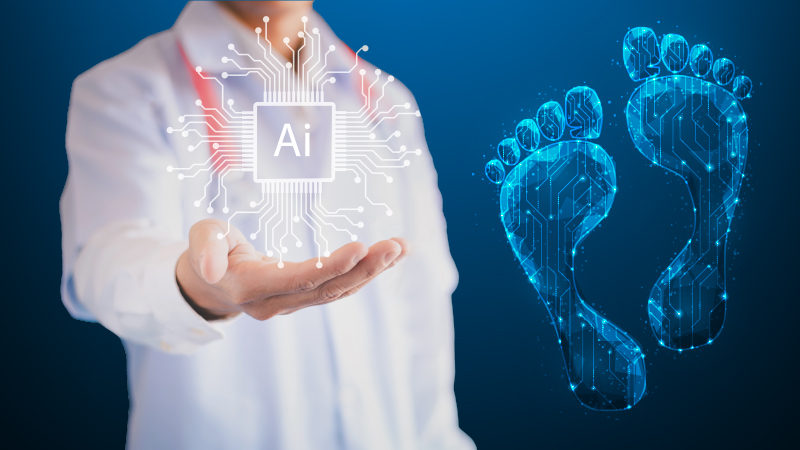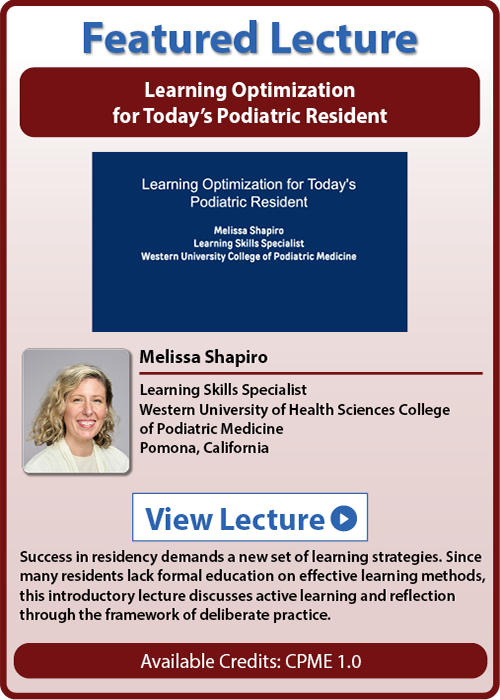
Practice Perfect 931
An AI-Written Article About Using AI In Podiatry Practice
An AI-Written Article About Using AI In Podiatry Practice

Recently, PRESENT CEO Alan Sherman, DPM and I were discussing the use of artificial intelligence (AI) within podiatry. Although it seems inevitable – and perhaps even a good thing – it’s not an easy task to see where it will fit and where the benefits and risks will pop up. We’ve recently heard about one particular healthcare system that uses an AI application in a smartphone to listen to a patient encounter and create an encounter note. This is my personal favorite AI use, because, as someone who spends a lot of time charting (AKA anyone in medicine!), I would love to offload this part of the job.
Another arena in which AI is increasingly cropping up is in the “creative” space, where AI can, for example, write an editorial about a podiatric topic. Now, as an editorialist I don’t find it appropriate to have someone else write my articles as it feels disrespectful to those of you taking the time to read them. As such, I’ve never used AI to write Practice Perfect (I guess you’ll have to take my word on that). However, curiosity demands that I at least find out what kind of quality will come from this type of “assistance.” To that end, I logged onto Chat GPT and asked it to “write a 400-word paper about the use of artificial intelligence in podiatry.” What you see below is the unedited result. I didn’t change a word, including titles and punctuation. See what you think. After AI article, I offer some comments.
Embracing AI in Podiatry: A Leap Towards Precision
and Efficiency
Artificial Intelligence (AI) is revolutionizing numerous medical fields, and podiatry is no exception. As technology advances, AI is reshaping podiatry practices by enhancing diagnostic accuracy, streamlining workflows, and personalizing patient care. This editorial explores how AI is transforming podiatry and highlights the opportunities and challenges that come with this technological shift.
Transforming Diagnostics
AI’s most immediate impact in podiatry lies in its ability to improve diagnostic accuracy. Traditional diagnostic methods, while effective, are subject to human error and variability. AI systems, particularly those utilizing machine learning, excel in analyzing complex data sets and identifying subtle patterns that may escape the human eye. For instance, AI algorithms can scrutinize medical images—such as X-rays and MRIs—to detect fractures, tumors, or degenerative changes with remarkable precision. This capability is especially beneficial in diagnosing conditions like diabetic foot ulcers, where early detection can significantly impact treatment outcomes.
Streamlining Operations
Beyond diagnostics, AI is also streamlining administrative tasks in podiatry practices. Scheduling, billing, and patient management are often cumbersome and time-consuming. AI-driven tools can automate these processes, reducing the administrative burden on healthcare professionals and allowing them to devote more time to patient care. Automated scheduling systems can optimize appointment bookings and manage cancellations, while AI-powered EHR systems can ensure accurate record-keeping and regulatory compliance. These efficiencies not only improve practice operations but also enhance the patient experience by reducing wait times and ensuring timely follow-ups.
Personalizing Treatment
AI also plays a crucial role in tailoring treatment plans to individual patients. By analyzing data from various sources—such as medical history, genetic information, and lifestyle factors—AI systems can generate personalized recommendations for treatments and interventions. This personalized approach is particularly valuable in managing chronic conditions like plantar fasciitis or peripheral neuropathy, where customized care can lead to better outcomes.
Navigating Challenges
Despite its benefits, the integration of AI in podiatry presents challenges. Data privacy and security are major concerns, as AI systems require access to extensive patient information. Podiatry practices must implement robust security measures and adhere to regulations to protect patient data. Additionally, continuous education is necessary for practitioners to effectively utilize AI tools and interpret their results.
Looking Ahead
The future of AI in podiatry holds immense promise. As technology evolves, we can anticipate more advanced tools that further enhance diagnostics, streamline practice operations, and provide even more personalized care. Embracing AI offers a path to greater precision and efficiency in podiatry, ultimately benefiting both practitioners and patients. As we navigate this technological frontier, the goal remains clear: to harness AI’s potential to advance podiatric care and improve patient outcomes.
After reading this, what do you think? Here are a few thoughts of mine.
1. It’s structured exactly how we are taught to write a short paper with an intro paragraph that includes a three-point thesis, paragraphs for each of the thesis points, and a conclusion. My college freshman English teacher would have been happy with that.
2. It’s actually pretty generic. You could insert any medical specialty into this article, and it would still make sense.
3. The information is reasonable but not earth-shatteringly unique. There was nothing that surprised me or was particularly thought-provoking.
4. It lacks a human quality. Maybe I’m just showing my age here.
On the whole, it’s a decent article, impressively written in a matter of a few seconds, but one that lacks detail, specificity, or creativity. It’s kind of boring and vanilla, lacking panache. But it’s a strong start that provides at least a good framework in which one might write something a little more creative. I’m sure we’ll see a lot more to come on this topic!
Best wishes.

Jarrod Shapiro, DPM
PRESENT Practice Perfect Editor
[email protected]





























Comments
There are 0 comments for this article